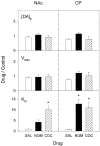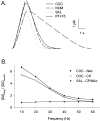Preferential increases in nucleus accumbens dopamine after systemic cocaine administration are caused by unique characteristics of dopamine neurotransmission
- PMID: 11487657
- PMCID: PMC6763153
- DOI: 10.1523/JNEUROSCI.21-16-06338.2001
Preferential increases in nucleus accumbens dopamine after systemic cocaine administration are caused by unique characteristics of dopamine neurotransmission
Abstract
In vivo voltammetry was used to investigate the preferential increase of extracellular dopamine in the nucleus accumbens relative to the caudate-putamen after systemic cocaine administration. In the first part of this study, cocaine (40 mg/kg, i.p.) was compared with two other blockers of dopamine uptake, nomifensine (10 mg/kg, i.p.) and 3beta-(p-chlorophenyl)tropan-2beta-carboxylic acid p-isothiocyanatophenylmethyl ester hydrochloride (RTI-76; 100 nmol, i.c.v.), to assess whether the inhibitory mechanism of cocaine differed in the two regions. All three drugs robustly increased electrically evoked levels of dopamine, and cocaine elevated dopamine signals to a greater extent in the nucleus accumbens. However, kinetic analysis of the evoked dopamine signals indicated that cocaine and nomifensine increased the K(m) for dopamine uptake whereas the dominant effect of RTI-76 was a decrease in V(max). Under the present in vivo conditions, therefore, cocaine is a competitive inhibitor of dopamine uptake in both the nucleus accumbens and caudate-putamen. Whether the preferential effect of cocaine was mediated by regional differences in the presynaptic control of extracellular DA that are described by rates for DA uptake and release was examined next by a correlation analysis. The lower rates for dopamine release and uptake measured in the nucleus accumbens were found to underlie the preferential increase in extracellular dopamine after cocaine. This relationship explains the paradox that cocaine more effectively increases accumbal dopamine despite identical effects on the dopamine transporter in the two regions. The mechanism proposed for the preferential actions of cocaine may also mediate the differential effects of psychostimulant in extrastriatal regions and other uptake inhibitors in the striatum.
Figures








Similar articles
-
Concurrent autoreceptor-mediated control of dopamine release and uptake during neurotransmission: an in vivo voltammetric study.J Neurosci. 2002 Jul 15;22(14):6272-81. doi: 10.1523/JNEUROSCI.22-14-06272.2002. J Neurosci. 2002. PMID: 12122086 Free PMC article.
-
Determination of release and uptake parameters from electrically evoked dopamine dynamics measured by real-time voltammetry.J Neurosci Methods. 2001 Dec 15;112(2):119-33. doi: 10.1016/s0165-0270(01)00459-9. J Neurosci Methods. 2001. PMID: 11716947
-
Dopamine transporter synthesis and degradation rate in rat striatum and nucleus accumbens using RTI-76.Neuropharmacology. 2000 Feb 14;39(4):578-85. doi: 10.1016/s0028-3908(99)00160-4. Neuropharmacology. 2000. PMID: 10728879
-
In vivo interaction of cocaine with the dopamine transporter as measured by voltammetry.Eur J Pharmacol. 2003 Oct 31;479(1-3):117-25. doi: 10.1016/j.ejphar.2003.08.062. Eur J Pharmacol. 2003. PMID: 14612143 Review.
-
Comparison of cocaine- and methamphetamine-evoked dopamine and glutamate overflow in somatodendritic and terminal field regions of the rat brain during acute, chronic, and early withdrawal conditions.Ann N Y Acad Sci. 2001 Jun;937:93-120. doi: 10.1111/j.1749-6632.2001.tb03560.x. Ann N Y Acad Sci. 2001. PMID: 11458542 Review.
Cited by
-
Maturation of the human striatal dopamine system revealed by PET and quantitative MRI.Nat Commun. 2020 Feb 12;11(1):846. doi: 10.1038/s41467-020-14693-3. Nat Commun. 2020. PMID: 32051403 Free PMC article.
-
A mathematical model for the role of dopamine-D2 self-regulation in the production of ultradian rhythms.PLoS Comput Biol. 2024 May 3;20(5):e1012082. doi: 10.1371/journal.pcbi.1012082. eCollection 2024 May. PLoS Comput Biol. 2024. PMID: 38701077 Free PMC article.
-
Effects of cocaine on monoamine uptake as measured ex vivo.Neurosci Lett. 2007 Feb 21;413(3):191-5. doi: 10.1016/j.neulet.2006.11.041. Epub 2006 Dec 13. Neurosci Lett. 2007. PMID: 17169488 Free PMC article.
-
Zwitterionic Polymer Coated and Aptamer Functionalized Flexible Micro-Electrode Arrays for In Vivo Cocaine Sensing and Electrophysiology.Micromachines (Basel). 2023 Jan 27;14(2):323. doi: 10.3390/mi14020323. Micromachines (Basel). 2023. PMID: 36838023 Free PMC article.
-
Dopamine D3 autoreceptor inhibition enhances cocaine potency at the dopamine transporter.J Neurochem. 2016 Sep;138(6):821-9. doi: 10.1111/jnc.13732. Epub 2016 Aug 15. J Neurochem. 2016. PMID: 27393374 Free PMC article.
References
-
- Bergstrom BP, Garris PA. Utility of a tripolar stimulating electrode for eliciting dopamine release in the rat striatum. J Neurosci Methods. 1999;87:201–208. - PubMed
-
- Bjorklund A, Lindvall O. Dopamine-containing systems in the CNS. In: Bjorklund A, Hokfelt T, editors. Handbook of chemical neuroanatomy. Elsevier; New York: 1984. pp. 55–122.
-
- Boja JW, Kuhar MJ. [3H]cocaine binding and inhibition of [3H]dopamine uptake is similar in both the rat striatum and nucleus accumbens. Eur J Pharmacol. 1989;173:215–217. - PubMed
-
- Cahill PS, Walker QD, Finnegan JM, Mickelson GE, Travis ER, Wightman RM. Microelectrodes for the measurement of catecholamines in biological systems. Anal Chem. 1996;68:3180–3186. - PubMed
Publication types
MeSH terms
Substances
Grants and funding
LinkOut - more resources
Full Text Sources
